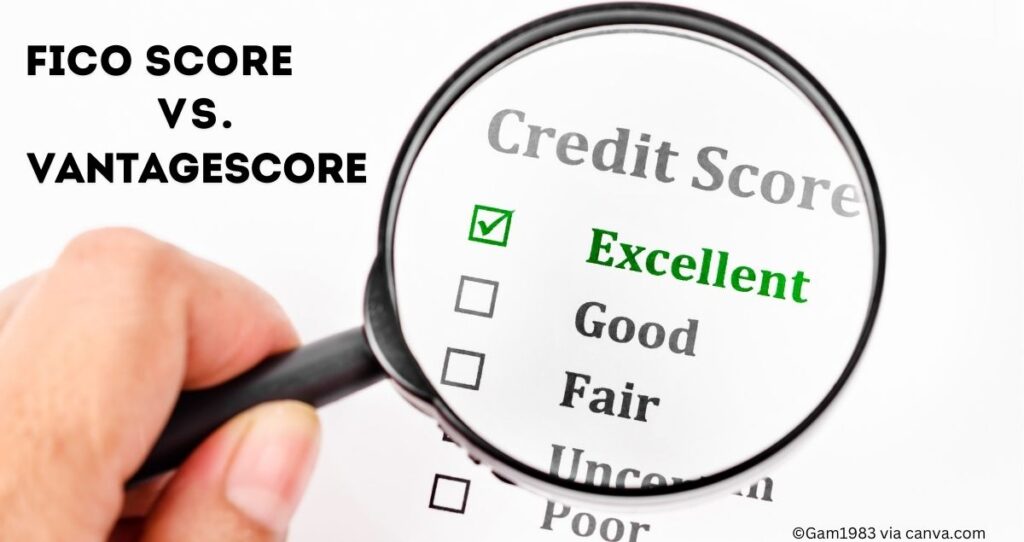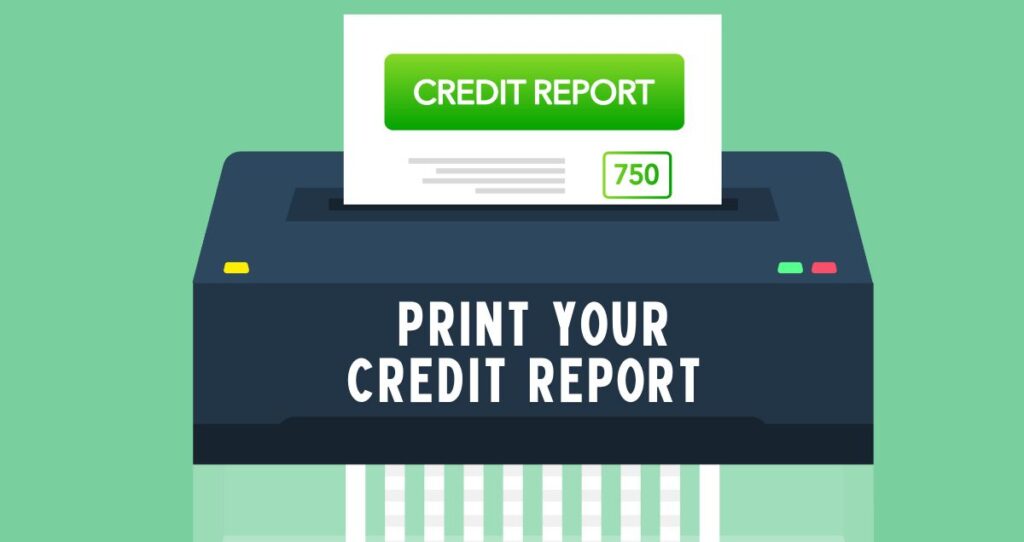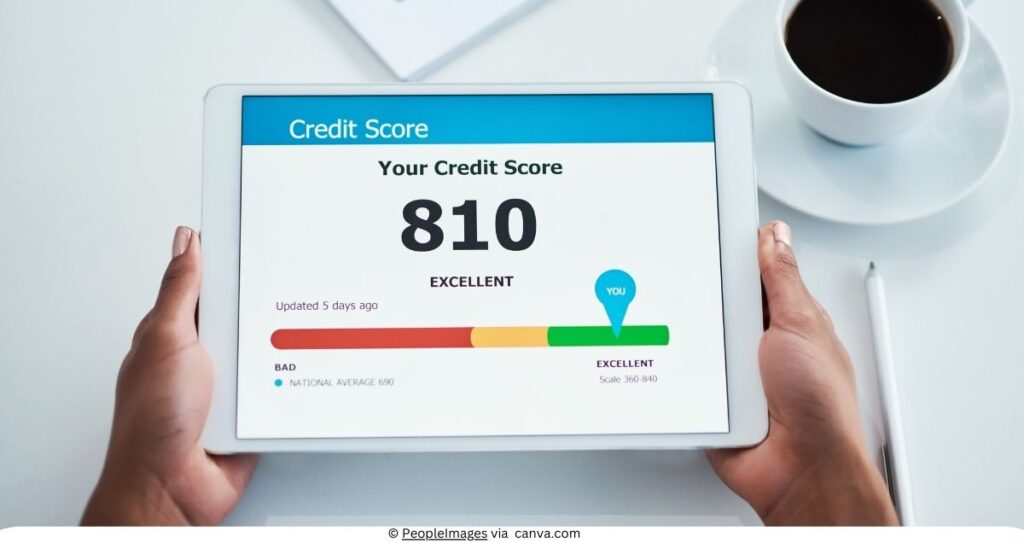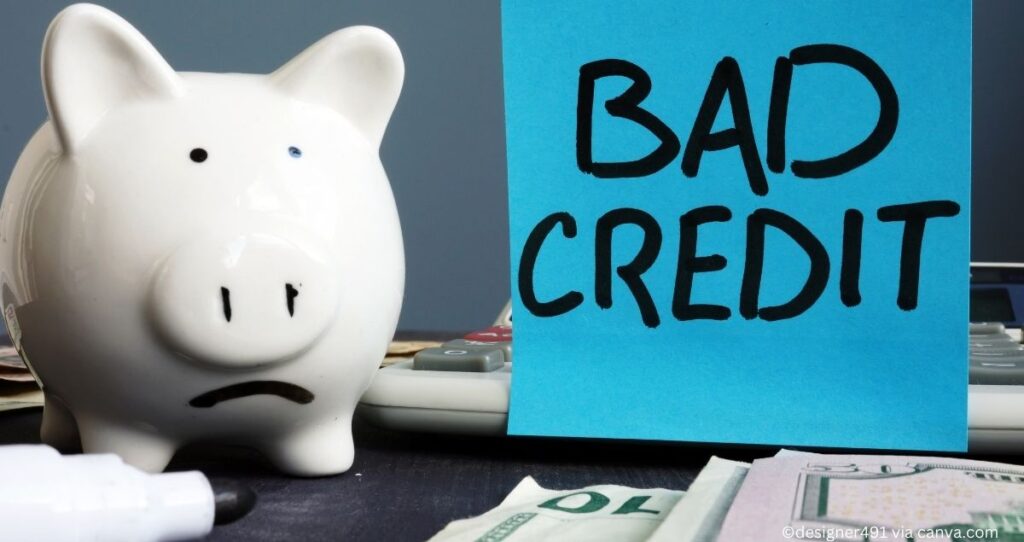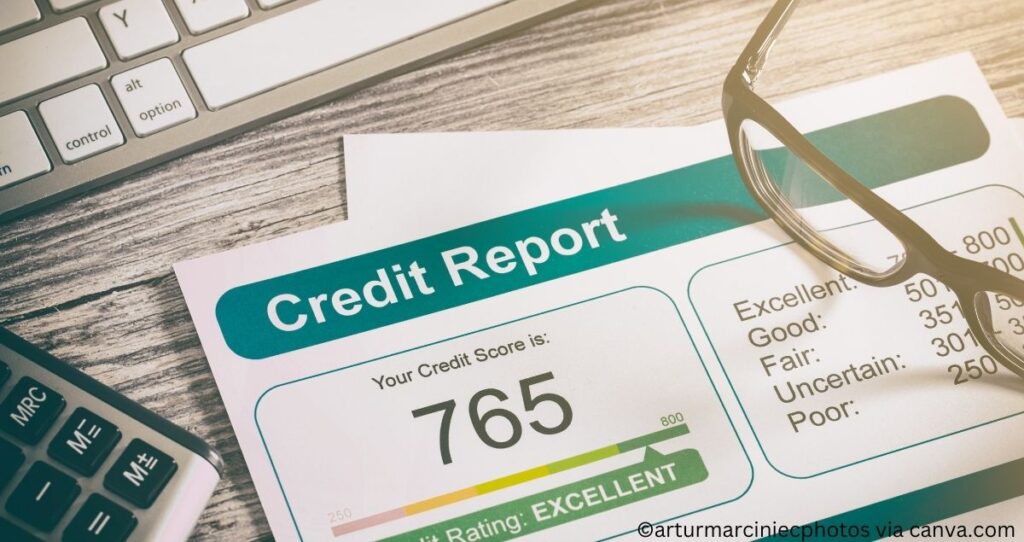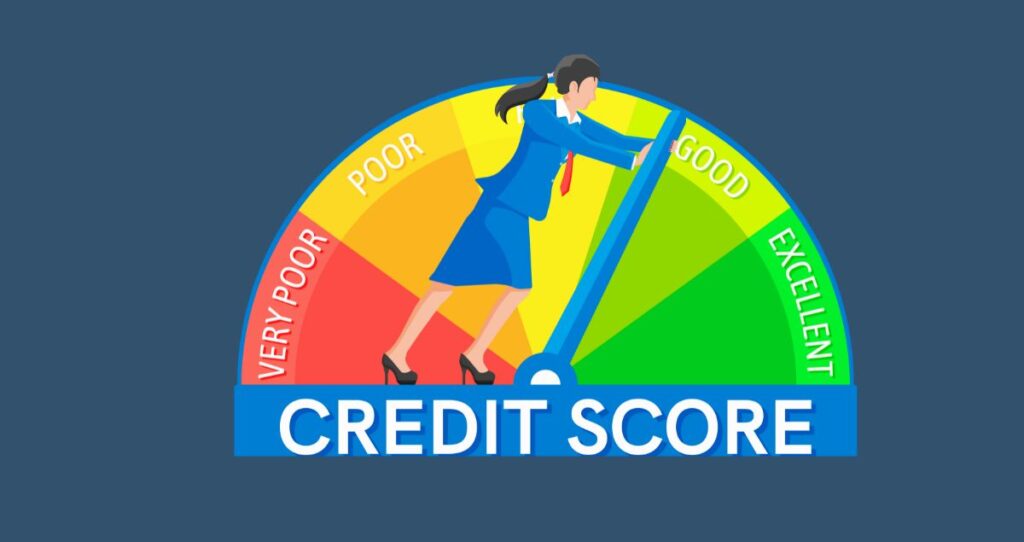Have you ever wondered how your FICO score differs from your VantageScore or which score you should focus on when building credit? Learning about credit scores and reporting can be confusing, especially if you are new to credit. In this article, I will compare the FICO score vs. VantageScore, including factors affecting each score to help you focus on the right score when building credit.
Many varieties of credit scores are used for consumer credit reporting, but the most used are the FICO and VantageScore. Over 90% of lenders use your FICO score for loans, while a small percentage use other scores, with the VantageScore being the second on the list. The VantageScore and FICO scores range from 300 to 850, but they are calculated by different companies using different credit scoring models. The FICO is calculated by Fair Isaac Corporation(FICO), while the VantageScore is calculated by the three credit reporting agencies(Equifax, TransUnion, and Experian).
This post will explain the key differences between the FICO score and the VantageScore and the factors affecting each type of score.
Article summary
- The Fair Isaac Corporation, a pioneer of consumer credit scoring, calculates the FICO score.
- Credit reporting agencies(Equifax, TransUnion, and Experian) calculate the VantageScore.
- Over 90% of lenders use FICO scores for loan applications.
- The credit score you find online is not necessarily what your lenders will use or see when you apply for loans.
- FICO score and VantageScore range between 300 and 850 and are used to assess your creditworthiness
- Having different credit scores doesn’t mean one is more accurate. Instead, the difference comes from different scoring models used to calculate your scores. Other factors that lead to different credit scores include the following.
- Your lenders might not report to all credit reporting agencies, leading to different information on your credit reports.
- Different credit reporting agencies apply different weights to information in your credit reports.
- Lenders use different credit scores based on industries, but the FICO score is the most preferred, as 90% of lenders use it for loan applications.
- Both FICO Score and VantageScore are calculated using information from your credit reports.
- You can get a free credit report once every 12 months from each credit reporting agency through the Annualcreditreport.com website.
- The top factors affecting your FICO score and VantageScore are payment history, the length of your credit history/ credit age, and credit utilization.
- You can check your FICO score and VantageScore for free online. For example, a Discover credit card comes with free FICO scorecard information. You can check your VantageScore from CreditKarma.com and similar websites.
What is a FICO score?
FICO score is a credit score that ranges from 300 to 850 and is calculated by Fair Isaac Corporation(FICO) using the FICO score model. This model uses information from credit reports to calculate your FICO score. MyFICO says over 90% of lenders use FICO scores for loan applications. So, if you want to get loans faster with lower rates, improve your FICO score. The good news is that factors that affect your FICO score also affect your VantageScore. So, any measures you take to boost your FICO score, such as paying your bills on time, getting credit repair loans, and maintaining a lower credit utilization, will also improve your VantageScore.
Six factors affect your FICO score: payment history, credit utilization, length of credit history, credit mix, hard inquiries, and derogatory marks.
While FICO and credit reporting agencies use the same information from your credit reports to calculate your scores, your VantageScore and FICO scores will not be the same. This is because FICO uses the FICO score model to calculate your FICO score, while credit reporting agencies use the VantageScore model to calculate your VantageScore. Each model applies different weights to information in your credit reports, resulting in different credit scores.
What is a VantageScore?
A VantageScore is a type of credit score ranging from 300 to 850. Credit reporting agencies calculate your VantageScore using information from your credit reports collected regularly from your lenders. There are three major credit reporting agencies, including the following.
- Equifax
- TransUnion
- Experian
Each credit reporting agency uses its proprietary VantageScore model to calculate your VantageScore. For example, Equifax will calculate your Equifax score using information from your Equifax credit report. Similarly, Experian calculates your Experian score using information from your Equifax credit reports. This means the VantageScore you see online might not be the same even if the information in your credit reports is the same.
A higher VantageScore means you carry less risk. As a result, you get rewarded with lower loans, get approved faster, qualify for more money, and have favorable terms. A higher score gives you a lot of negotiating power.
A few factors affect your VantageScore, including payment history, age of your credit, credit utilization, credit mix, new account activities, available credit, and total debt on your credit report.
You can check our VatnageScore free online from websites like CreditKarma.com. All you have to do is create an account and check your score for free whenever you want.
What affects the FICO score?
Many factors affect your FICO score, and the FICO score model applies weights to each factor. Typically, the most critical factors on your FICO score are your payment history, credit utilization rate, and the length of your credit history, as they account for 35%, 30%, and 15% of your FICO score, respectively.
A list of all factors affecting your FICO score.
- Payment history. Your payment history is the most significant factor in your FICO score, accounting for 35% of its calculations. The FICO score model applies more weight to this factor, as paying your bills on time is crucial in assessing how risky it is to lend you money.
- Credit utilization. Credit utilization is the second most significant factor affecting your FICO score, accounting for 30% of its calculations. A higher utilization sends a mixed signal, indicating you might be relying on debt to finance your lifestyle. Keep your credit utilization under 5% to maintain a high FICO score.
- Length of credit age. How long you have been using credit is a significant factor in your FICO score, accounting for 15% of its calculations. The longer you have been using credit, the more trustworthy you become. That is why people with over ten years of excellent credit activities usually have over 800 credit scores.
- Credit mix. Your credit mix refers to the different types of credit accounts on your credit reports, accounting for 10% of your FICO score. A good credit mix combines revolving credit, such as credit cards, with installment loans, such as mortgages.
- Hard inquiries. You get a hard inquiry on your credit reports when you apply for loans and other forms of credit. Hard inquiries account for 10% of your FICO score, and it is best to avoid excessive borrowing, as each hard pull results in a credit score drop of 5-6 points on average.
What affects VantageScore?
Some factors affect your VantageScore and are similar to your FICO score factors. As we discussed earlier, however, the VantageScore model applies different weights to these factors, resulting in the difference between FICO and VantageScore.
Here is a list of all factors affecting your FICO score and different weights for each factor.
- Payment history (40%). Like your FICO score, VantageScore also puts more weight on your payment history, accounting for 40% of its calculation. Paying your bills on time is essential in improving your credit score, as more weight means more points you can get.
- Age of your credit and credit mix (21%). The age of your credit is the average age of all your credit accounts on your credit reports. The VantageScore combines your credit mix with the age of your credit for 21% of its calculations. A good credit mix means that you can manage different loan products.
- Credit Utilization(20%). Your credit utilization is the amount you have spent compared to the available credit limit. If you have a credit limit of $1,000 and spend $400, your credit utilization will be 40%. The credit utilization affects VantageScore calculation by 20%.
- Total debt/total credit balance(11%). This factor refers to your total debt, accounting for 11% of your VantageScore calculations.
- New account activities(6%). New credit refers to the number of times you recently applied for new credit, similar to hard inquiries for FICO score.
- Available credit (3%). The available balance on your credit accounts accounts for 3% of your VantageScore.
Fico score vs. VantageScore
Both VantageScore and FICO scores range between 300 and 850. The higher the score in this range, the lower the risk of lending you money. That is why you get lower loans, favorable terms, and qualify for more money when you have a good credit score (740+score).
It is critical to remember that the credit score you see online differs from the one your lender will use when applying for loans. Your lenders might not even see the same number or close to it. However, the FICO score you see online might be close to what your lender will see but will not necessarily be the same.
When you check your credit score online, you will notice that it is categorized into Good, Bad, Excellent, Poor, etc. This is because there are credit score ranges of values that help lenders categorize borrowers. These ranges make up what is known as a credit score chart. As you increase your credit score, you move from one range to another on the credit score chart. For example, if you have a Fair FICO Score (580-669) and increase it to a Good FICO score(670-739), you will notice that many lenders are willing to give you loans, although the interest might still be high.
So, what is the difference between the FICO score and VantageScore regarding credit score ranges?
The following table shows different credit score ranges for FICO and VantageScore and how they are compared.
FICO score vs. VantageScore
| VantageScore rating | VantageScore Range | FICO score rating | FICO Score Range |
| Very poor | 300-499 | Poor | 300-579 |
| Poor | 500-600 | Fair | 580-669 |
| Fair | 601-660 | Good | 670-739 |
| Good | 661-780 | Very good | 740-799 |
| Excellent | 781-850 | Exceptional | 800-850 |
As you can see from the table above, the FICO score and VantageScore have different credit score ranges. For example, a VantageScore in the poor range is between 500 and 600, while a Poor FICO score ranges between 300 and 579. Another difference can be observed in the last range of these two scores. An excellent VantageScore is between 781 and 850, while an exceptional FICO score is between 800 and 850.
If your lender uses a FICO score and you have an exceptional score, you will qualify for the lowest interest the lender offers. A person with an 800 score and an 850 will qualify for similar rates since their scores are in the same category. The same applies to your VantageScore.
Who founded FICO and VantageScores?
The FICO score was founded by Fair Isaac Corporation (FICO) and is calculated using the FICO score model. FICO is a publicly traded data analytics company based in Montana with additional locations in California and Minnesota. This company was founded by engineer William R. Bill Fair and mathematician Earl Judson Isaac in 1956. The FICO score model was introduced in 1989 to help lenders evaluate borrowers’ creditworthiness and was the first industry-standard consumer credit scoring system. Since then, thousands of businesses have adopted the FICO score, and over 90% of loans have been approved based on FICO scores.
On the other hand, VantageScore was founded in 2006 by three credit reporting agencies(Equifax, TransUnion, and Experian) in a joint venture to compete with FICO. Similarly to the FICO score, VantageScore uses information from your credit reports to calculate your credit scores. A new credit scoring model was created, famously known as the VantageScore model, hence the name VantageScore. Many versions of this model have been introduced since, with the latest model being VantageScore 4.0. While the VantageScore has gained popularity, most lenders still use the FICO score, especially in the mortgage and car loan industries.
How long does it take to get your first FICO score and VantageScore?
If you are new to credit score and credit building, you might not get your first credit score until after a few months. This is because it takes a while for your credit reports to meet the credit scoring minimum requirements before your credit score can be generated. It takes longer to get your first FICO score than VantageScore.
Typically, it takes at least six months of credit usage to get your first FICO score. Your credit reports must have a tradeline, such as a loan, credit card, mortgage, personal loan, etc., active for at least six months. After six months, your score gets updated regularly, usually monthly, as lenders submit your account activities to credit reporting agencies.
On the other hand, qualifying for a VantageScore is much easier. All you need is one tradeline that has been active for at least 30 days. After 30 days, your first VantageScore will be generated regularly as credit bureaus receive new information from your lenders.
NOTE: The term tradeline refers to a credit account that appears on your credit reports, such as a credit card, a personal loan, or a mortgage.
How is your credit score calculated?
Credit scoring companies use information from your credit reports to calculate your credit scores. To do so, a credit scoring model assigns different points to information from your reports. Think of a scoring model as an algorithm designed to reward points by assigning different weights to information it finds in your credit reports.
The model scans your credit reports and gives you points based on what it finds. While your credit reports contain a lot of information, only your payment history, credit utilization, age of the credit/length of your credit, credit mix, new account activities, loan values, negative items in your reports, and how much you owe are used to calculate your credit scores.
Among these factors affecting your FICO and VantageScore, the payment history, credit Utilization, and the age of your credit have the highest impact on both credit scores. That is why your credit score drops more than 100 when a single late payment is reported on your credit reports.
Is FICO more important than VantageScore?
After seeing many different credit scores, you might wonder if your FICO score is more important than your VantageScore. Both credit scores are important as they reflect the health of your credit and are used for loans and credit card application processes. For example, if your VantageScore suddenly dropped, it might indicate negative items, fraudulent activities, or errors in your credit reports. From this information, you can take action to clean up your credit reports. The same information can also be reflected as both credit scores are calculated using information from your credit reports.
However, your FICO score is more important than your VantageScore when taking out loans because most lenders prefer consumer FICO scores when approving consumer loan applications. According to myFICO, 90% of lenders use FICO scores when assessing consumers’ creditworthiness. That means you will more likely be judged based on your FICO Score than your VantageScore when you take out a loan.
Some lenders still use VantageScore instead of FICO scores to approve laon applications. For example, most credit card companies use VantageScore instead of FICO scores because of the heavy weight placed on your payment history compared to your FICO score. Credit cards are unsecured loans, which means there is no collateral. The lack of collateral means lenders must rely on your credit score, income, and DTIO ratio to approve you for credit.
More credit score tips
Is the Credit Karma score accurate?
